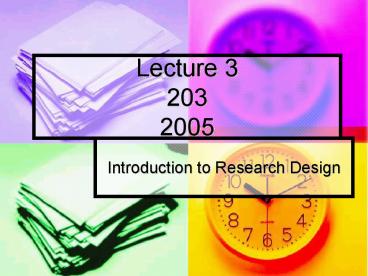Introduction to Research Design PowerPoint PPT Presentation
1 / 16
Title: Introduction to Research Design
1
Lecture 32032005
- Introduction to Research Design
2
The principle of falsifiability
- Theories must be stated in ways that make it
possible to refute or disconfirm - Predict what will/will not happen
- Those who believe in water divining, and ESP will
frequently not agree on what constitutes
evidence. - Have you ever observed pointless arguments
between believers and non-believers?
3
Flaws in thinking as part of everyday life
- Telling anecdotes a personal story to support
or refute a general point - Refers to instinct or laws of nature or what
everyone knows - Uses correlational data as causal (there has been
a huge increase in crime since mothers started
working) - Uses emotional language instead of reason and
evidence (dumping babies in child care to be
looked after by a stranger has to be harmful) - Taken from Dian Halpern APA President 2004
Monitor on Psychbology February issue)
4
3 Goals of Science
- Description
- Careful observation of events and the conditions
under which they occur. - Step one in the development of a theory
- Prediction
- Defines when events will and will not occur
- May allow us to identify magnitude and frequency
and perhaps make judgments of importance - Explanation
- Specify cause and effect
- Many causes maybe identified each with a varying
degree of influence (e.g. the causes of heart
disease)
5
Basic and Applied Research
- Basic Science knowledge for its own sake.
- The development of logical thought in children
- Memory for different kinds of word lists
- Perception of transparency, depth, motion, light
etc. - Facial features and mate selection
- Bodily odours and sexual attraction
- Each may start out as an interest of groups of
researchers the findings of which may or may not
be developed for practical use.
6
Practical uses of basic research
- Development of logical thought
- a test for diagnosing developmental disability
- Memory for word lists
- design of specialised vocabularies for
communication (e.g. aviation) - Perception of depth
- environmental design to warn of hazards (e.g.,
warning lights) - Facial features
- advertising
- Bodily odours
- - perfume
7
Applied Research
- In Clinical settings What type of therapy
alleviates depression? - In Educational settings What is the best way to
teach children how to read? - In Sport Psychology How does training regime
impact on performance? - In Organisational settings What form of
management style motivates employees?
8
Research Methods
- Three broad types
- Descriptive Methods
- Relational Methods
- Experimental Methods
9
Descriptive Methods
- Observational Studies
- Naturalistic courting behaviour in nightclubs
- Participant/Action Research
- Laboratory Observation observation of children
in a playgroup (allows some manipulation) - Case Study Methods
- N1 in depth analysis (Freud, Piaget)
- Is generalisability and replicability a problem?
10
Descriptive Methods II
- Survey Methods
- Mail, Phone, Web
- Large samples often used
- Problems include
- Opportunism
- Response rates
- Gaining access
- Difficult to assign causation
11
Demonstration of Sampling Error
Acceptable
Unacceptable
Unacceptable
12
Predictive Relational (correlational) Methods
- A step up from description in the demonstration
of co-variation the correlational method - If a correlation can be demonstrated then
predictions can be made from the knowledge of one
variable only.
13
Using Correlation for Prediction
14
Test Score Scatterplot with Hypothetical Cutoffs
Figure 5.13
15
Questions about the Correlational Method
- Height and weight are correlated - what can you
not conclude? - Pain experienced in child birth and foot size are
strongly correlated can you conclude anything? - After watching a violent TV program children are
more aggressive. What can you conclude? - But - You can infer causation from correlation
under some circumstances using a combination of
sophisticated methodology and statistical
techniques
16
Next Lecture
- The experimental method
- Its strengths
- Its weaknesses

